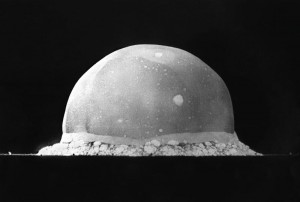At half past five on the morning of July 16th 1945, The Gadget exploded and the whole world shook. Three square miles of desert sand was melted into glass. A mushroom cloud rose almost 8 miles into the sky and cast a shadow that darkens our world even now. For it was on this day, in the final year of the second world war, that humanity entered the atomic age. A day of infamy. A day to lament. A day on which we should – as a species – collectively reflect on just how far our ingenuity has exceeded our wisdom.
Technological progress is like an axe in the hands of a pathological criminal.
– Albert Einstein
The Manhattan Project officially began in 1942, though its roots lay in a letter to President Franklin D. Roosevelt, written by a group of concerned scientists including Albert Einstein. Aware that the Nazis were attempting to develop nuclear weapons and terrified by the prospect, the authors of the letter urged Roosevelt to begin research into the technology. Einstein – whose involvement in the project ended with that letter in October 1939 – would later describe adding his signature as the “one mistake in my life” and insisted that he never would have done so had he known that fascist Germany would be unsuccessful in developing the bomb.
But the die had been cast. And a few months after the Japanese attack on Pearl Harbour, Major General Leslie Groves – the son of a Presbyterian pastor – was selected to run a top secret project, codenamed “Manhattan”. Groves was given almost free rein with regards to funding and the selection of staff; spending almost $2 billion (and that’s 1945 dollars) and employing some of the finest scientists and engineers of the era. Perhaps the most famous of whom was Julius Robert Oppenheimer, the theoretical physicist who led the design team.
Now, I am become Death, the destroyer of worlds.
– J. Robert Oppenheimer (quoting the Bhagavad Gita)
The Manhattan Project took place at over 30 locations, mostly in the United States but work was also carried out in Britain and Canada. The three central facilities were in Hanford, Washington (where plutonium was manufactured), Oak Ridge Tennessee (where uranium was enriched) and, of course, Los Alamos, New Mexico where the design team worked and The Gadget – as the test bomb was codenamed – was assembled. The Los Alamos facility is generally considered the home of the Atom Bomb and has become a place of fascination and horror within popular consciousness… the birthplace of a monster.
Between 1942 and the end of 1944, suffering setbacks and experiencing triumphs, the Manhattan Project slowly produced the nuclear fuel required for four bombs. The first – The Gadget – was the test device. The second – Little Boy – was dropped on Hiroshima. The third – Fat Man destroyed the city of Nagasaki. The fourth, as it turns out, was not used… two bombs being enough to force an unconditional Japanese surrender. The potential targets for that last product of Los Alamos included Tokyo and Kyoto. By early 1945, Oppenheimer was confident that the design was complete and production of the final devices could begin.
The Japanese were ready to surrender and it wasn’t necessary to hit them with that awful thing.
– Dwight D. Eisenhower
On May 7th 1945 a preliminary explosion was carried out in the New Mexico desert when 108 tons of TNT mixed with plutonium was detonated. This first “dirty bomb” was intended to test the instruments that would record The Gadget, as well as provide an increasingly impatient military high-command with some fireworks. Over a billion and a half dollars had been sunk into the project by this point and results were being demanded. It has been suggested that the Japanese were ready to negotiate in May, and some believe the war was deliberately extended in order that the atomic might of the United States could be revealed to the world (particularly the Soviet Union). It’s difficult to know how much truth is in this theory, but there can be little doubt that – in every nation, in every era – there will always be people in power who wish above all things to demonstrate that power.
Which is why, at ten past five on the morning of July 16th 1945, a select group of soldiers, scientists and politicians sheltered in bunkers between 10 and 20 miles from The Gadget and watched the clock as the 20 minute countdown ticked away, second by second. Of all the people in the world, only they knew that the end of an era was upon us. That a time when human beings could extinguish all life on our planet with the push of a button was dawning. And that they were ushering it in. Midwives to the monster. As half past five drew closer, darkened glasses were donned and eyes shifted from the clock to the horizon. Somewhere out there in the Jornada del Muerto desert, at a place codenamed Trinity, a one hundred foot tower rose up out of the sand. Atop the tower was The Gadget.
We have genuflected before the god of science only to find that it has given us the atomic bomb, producing fears and anxieties that science can never mitigate.
– Martin Luther King Jr.
There was a flash of light. Had they not been wearing darkened goggles, the observers would have been blinded by it. Then a moment, an eerie moment in which nothing happened, as though the whole world had taken a sharp intake of breath. Humanity, as one, reduced to a cartoon character… we had run off the cliff and just remained there, suspended above the chasm, waiting for gravity – for the laws of physics – to visit upon us the consequences of our recklessness. And then Trinity exhaled. A poisonous wind rushed outwards in all directions, scorching all in its path, melting the very earth. For hundreds of miles in all directions, the ground shook and a terrible sound rang out. The gates of hell had been opened, and we have yet to find a way of closing them.
The fourteenth of John Donne’s Holy Sonnets opens with the line, Batter my heart, three person’d God. It was this that Oppenheimer was referring to when the named the test site “Trinity”. Part of him knew that his work would unleash a nightmare. Not just on the people of Hiroshima and Nagasaki, though they suffered first and as yet, worst. But on the entire human race. That the hearts of generations to come would be battered by the fear and paranoia that characterises our atomic age.
The release of atomic energy has not created a new problem. It has merely made more urgent the necessity of solving an existing one.
– Albert Einstein
Is our technology the product of our insanity? Or is it the other way round? Either way, the Manhattan Project is the ultimate manifestation of that insanity. When that bomb detonated in the New Mexico desert it created two separate futures for our species. In one, that explosion is a wake-up call. In the other, it is a death knell. As yet, we know not which future we have chosen to inhabit. But, let’s face it, the signs aren’t good.
[Written by Jim Bliss]



4 Responses to 16th July 1945 – the Manhattan Project